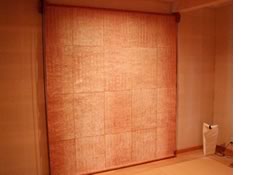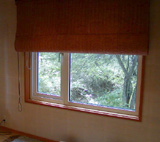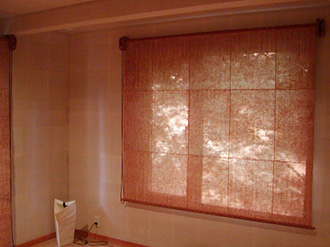
 |
|
 |
|
 |
|
The mountain air up in Yatsugatake, Uminokuchi (Nagano Prefecture) in late August feels quite chilly in the morning and the evening. The severe heat wave in the month of July, caused the crops in my vegetable garden to grow fast, and the corn and eda-mame (green soybean) were beginning to become too ripe and turn hard. The potatoes wait to be picked before leaving the mountain vacation home for Tokyo, at the end of the summer... For those who read last August, in Sidestory 009 (LINK), the episode about covering our wa-shitsu (Japanese tatami room) in our mountain house, with washi handmade paper, I wish to share my latest decorating touch to the room. Last summer, 4 expert kyouj-ya (wall paper hangers) from Tokyo redecorated the four and a half tatami room walls and the ceiling with the "fukuro-bari" (pouch pasting) method. What was left to do was to find the right curtains for the windows. Of course what would be natural will be a traditional shoji sliding screens. I knew they would fit well, but I wanted to try something new and different. It took me a full year to find the suitable and unique curtain. The new creation now dresses my windows blending perfectly well with the white washi walls. |

|
|
The process in making of the roll curtain I had a strong desire to make shibu-gami curtains and it came true at last! (Shibu-gami is handmade mulberry paper with a coating of persimmon tannin). Akira Murasato, hyogu-shi (Japanese hanging scroll mounter, screen maker), in Morioka City was the person who made my wish come true. First a piece of very thin silk cloth used for kake-jiku (Japanese hanging scrolls) is pasted onto the washi sheets. Next the washi is rolled around a piece of bamboo. By firmly rolling and wrapping the washi around the bamboo, fine creases are formed on the washi paper. The rolled and crinkled washi is then immersed into a basin with kaki-shibu (persimmon tannin) dye. Once the washi is dry, it is unrolled from the bamboo, and with a brush once again treated with persimmon tannin. Then each sheet is glued together at the edges to make the desired curtain size. Wooden rail rods are attached to the curtain on its both ends. The technique in rolling up the curtain is very simple. When you pull the string hung from the wooden upper rod, the string causes the rod to turn and pull up the curtain. This is the part that Murakami had the most trouble completing, without using ready-made gadgets. The part was actually handmade by his friend living just outside of Morioka City, Ryohei Kido, a woodworker. I was afraid the washi curtain edges will be damaged when operating the rolling strings, but once you get the knack you can easily roll the curtain up and down very smoothly. By wrapping the string onto the wooden piece, the curtain will remain fixed. |

|
|
A magazine editor friend who stayed with us this summer, remarked that she slept exceptionally well in the room. I hope the serenity and warmth that washi has, made my guest feel cozy, like a little silkworm in a cocoon. I must give my immense gratitude to the two craftsmen, who eagerly took charge of this troublesome project. I believe, with a little adjustment, they can commercialize this one-of-a-kind washi roll curtain. Is there anyone interested in having one in their house? |
|
(C)Copyright 2001 Jomon-sha Inc, All rights reserved. |
